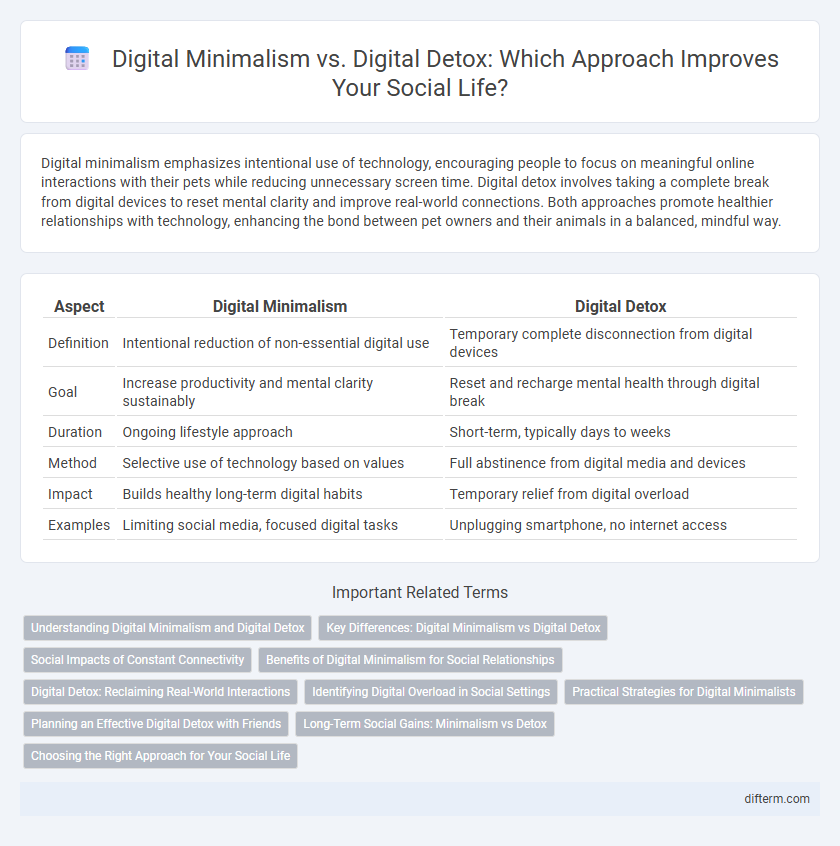Digital minimalism emphasizes intentional use of technology, encouraging people to focus on meaningful online interactions with their pets while reducing unnecessary screen time. Digital detox involves taking a complete break from digital devices to reset mental clarity and improve real-world connections. Both approaches promote healthier relationships with technology, enhancing the bond between pet owners and their animals in a balanced, mindful way.
Table of Comparison
| Aspect | Digital Minimalism | Digital Detox |
|---|---|---|
| Definition | Intentional reduction of non-essential digital use | Temporary complete disconnection from digital devices |
| Goal | Increase productivity and mental clarity sustainably | Reset and recharge mental health through digital break |
| Duration | Ongoing lifestyle approach | Short-term, typically days to weeks |
| Method | Selective use of technology based on values | Full abstinence from digital media and devices |
| Impact | Builds healthy long-term digital habits | Temporary relief from digital overload |
| Examples | Limiting social media, focused digital tasks | Unplugging smartphone, no internet access |
Understanding Digital Minimalism and Digital Detox
Digital minimalism emphasizes intentional technology use by prioritizing meaningful digital activities and reducing unnecessary screen time to enhance focus and well-being. Digital detox involves a temporary, complete disconnection from digital devices to relieve stress and reset healthy habits. Understanding these approaches helps individuals create sustainable digital boundaries tailored to their lifestyle and mental health needs.
Key Differences: Digital Minimalism vs Digital Detox
Digital minimalism emphasizes intentional technology use by prioritizing essential digital tools to enhance productivity and well-being, whereas digital detox involves a temporary complete disconnection from all digital devices to reduce stress and improve mental health. Digital minimalism fosters sustainable habits for long-term digital balance, while digital detox offers short-term relief from digital overload. Understanding these key differences helps individuals choose strategies best suited to their lifestyle and mental wellness goals.
Social Impacts of Constant Connectivity
Constant connectivity through digital devices often leads to increased social anxiety and reduced face-to-face interactions, impacting mental health and interpersonal relationships. Digital minimalism encourages intentional usage of technology, fostering deeper social connections and improved well-being by reducing distractions. In contrast, digital detox involves temporary disconnection that offers short-term relief but may not address long-term behavioral patterns affecting social dynamics.
Benefits of Digital Minimalism for Social Relationships
Digital minimalism improves social relationships by encouraging intentional technology use, which fosters deeper face-to-face interactions and reduces distractions from constant notifications. It helps individuals prioritize meaningful connections over digital noise, leading to enhanced emotional presence and empathy during social engagements. By setting clear boundaries on screen time, digital minimalism creates space for more genuine, focused conversations and strengthens interpersonal bonds.
Digital Detox: Reclaiming Real-World Interactions
Digital detox emphasizes intentional disconnection from digital devices to restore genuine face-to-face communication and enhance mental well-being. Reclaiming real-world interactions through a digital detox reduces dependence on social media and screen time, fostering deeper interpersonal relationships and mindfulness. This practice supports improved focus, emotional health, and a more balanced, present lifestyle in an increasingly digital society.
Identifying Digital Overload in Social Settings
Digital overload in social settings manifests through constant notifications, excessive screen time, and diminished face-to-face interactions, leading to decreased social presence and increased stress levels. Recognizing signs such as irritability, reduced attention span, and feeling overwhelmed by digital stimuli enables individuals to differentiate between digital minimalism, which emphasizes intentional use of technology, and digital detox, which involves temporary disconnection. Effective management of digital overload promotes healthier social connections and improved mental well-being.
Practical Strategies for Digital Minimalists
Digital minimalists prioritize intentional technology use by setting clear boundaries such as scheduled device-free hours and curating essential apps that serve specific purposes. Practical strategies include regular evaluation of digital habits, using tools like app blockers to limit distractions, and embracing analog alternatives for communication and entertainment. Incorporating mindfulness techniques helps digital minimalists maintain focus and reduce screen time without the need for complete digital abstinence.
Planning an Effective Digital Detox with Friends
Planning an effective digital detox with friends requires setting clear boundaries and designated tech-free zones to encourage meaningful face-to-face interactions. Establishing a shared schedule for offline activities, such as nature walks or board games, enhances engagement and accountability among participants. Prioritizing open communication about individual digital habits helps create a supportive environment that fosters long-lasting digital wellness.
Long-Term Social Gains: Minimalism vs Detox
Digital minimalism fosters sustainable long-term social connections by encouraging intentional technology use, enhancing meaningful interactions and reducing digital overwhelm. In contrast, digital detox offers temporary relief from social media overload but lacks the structural change needed to maintain lasting social gains. Embracing digital minimalism cultivates ongoing balance in digital engagement, promoting deeper relationships and consistent social well-being.
Choosing the Right Approach for Your Social Life
Digital minimalism emphasizes intentional use of technology to enhance meaningful social interactions by limiting digital distractions, while digital detox involves a temporary complete break from all digital devices to reset social habits. Choosing the right approach depends on individual social goals and lifestyle, with digital minimalism fostering long-term balance and digital detox offering short-term clarity. Evaluating your social media patterns and emotional response to technology helps determine whether gradual reduction or a full digital break will better improve your social well-being.
digital minimalism vs digital detox Infographic

 difterm.com
difterm.com